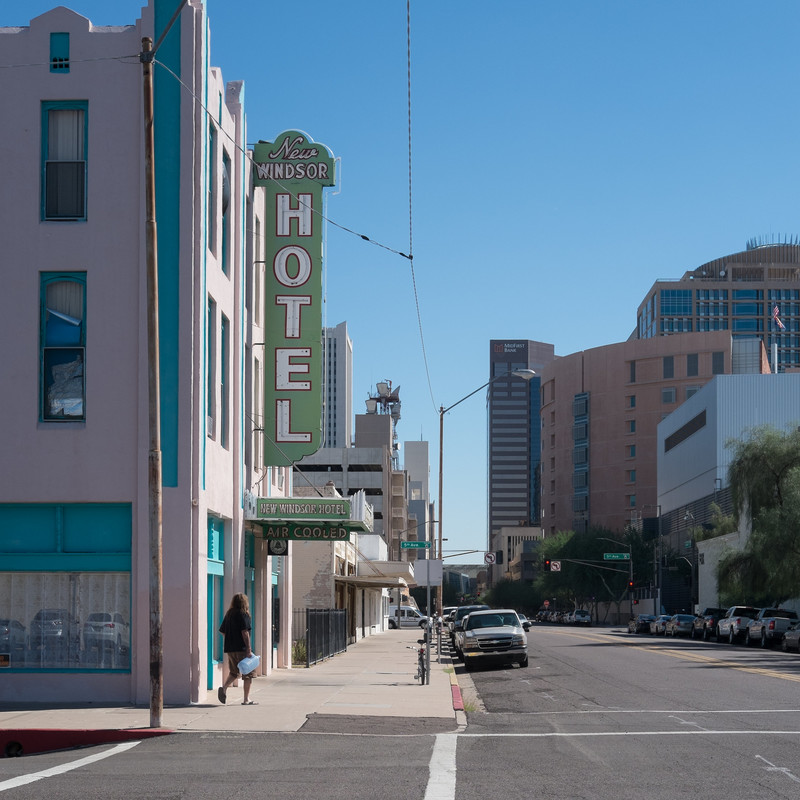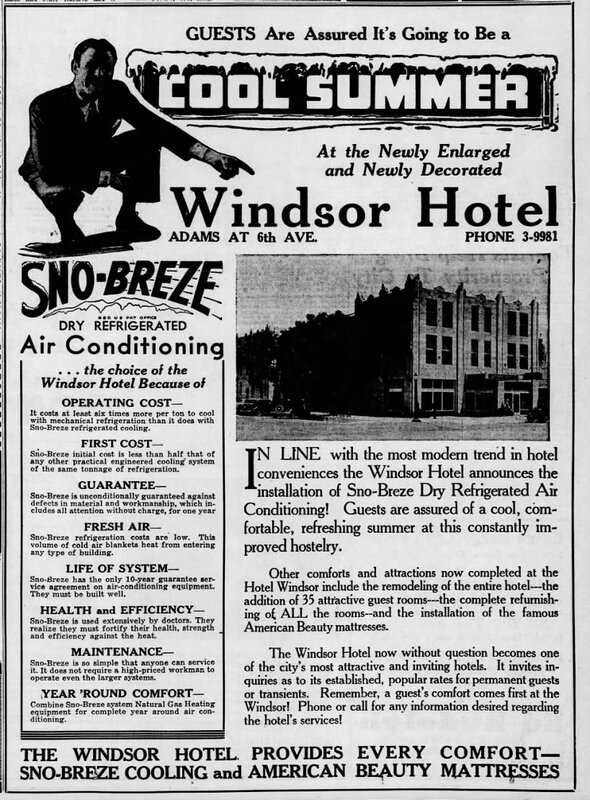
A resilient Victorian-era gem that has weathered the winds of change since its grand opening in 1893
The New Windsor Hotel is a survivor in downtown Phoenix. It was built in 1893 and had several remodels and name changes such as “The Windsor” and “The Sixth Avenue Hotel.” The hotel survived gentrification and was accepted into the National Register of Historic Places in 1985. The hotel is an example of Victorian style, modern aesthetics, and neon signs. The New Windsor Hotel is now used by the elderly because of its low budget accommodations.
A.D. Walsh built the New Windsor Hotel in 1893 on Sixth Avenue and Adams Street (546 W. Adams St.) Built in Victorian style, the Sixth Avenue Hotel became the largest hotel in the territory upon its opening. Walsh and his wife celebrated by hosting an Easter dinner in the hotel’s dining room. Mrs. Walsh had previously been a conductor of the Can Can restaurant in Tombstone and had built a reputation for herself as a restauranteer.
The hotel opened at precisely the moment that Phoenix began to transform. Phoenix had been a farming town with fewer than 5,000 people in 1893. There were more pool halls than lawyers, the new canal system had been freshly dug, and Phoenix had won the right to be the state capital from Prescott. The Sixth Avenue Hotel had become the place for dreamers moving to the Southwest to see if they could make their dreams come true. Within 25 years the population had grown almost ten times, and the region's growth continued to accelerate.
Architecturally, the hotel drew upon Victorian Era (1830-1910) styling, and The New Windsor introduced a dollhouse look with extravagant trims and loud colors influenced by Gothic architecture. The two-story brick hotel was renamed the Windsor Hotel in 1925 and later with the addition of another building, the New Windsor Hotel. The hotel was remodeled in 1935 adding a third story with a stucco façade (south and west walls) while adding a modern look by replacing some of the Victorian architecture. When additions were added in the 1950s the building was renamed the New Windsor Hotel.
The hotel lured guests with an unusual amenity in the 1930s that is evident on the "ghost sign" along the building's eastern facade. Along with the hotel's name, the words "air cooled" advertised the technology that so transformed the American South and Southwest after the 1930s. In 1937, the hotel took out a huge advertisement (almost half of a page), in the Arizona Republic touting its recent renovation. The hotel installed “Sno-Breze Dry Refrigerated Air Conditioning” and assured guests it was going to be a "cool summer." The ad claimed the air conditioning cut operating costs, lowered maintenance, and provided year-round comfort to customers. The hotel's clientele of permanent guests and transients no doubt appreciated the respite from the desert city's withering summer heat.
The New Windsor Hotel made the National Register of Historic Places in 1985 and is the only 19th-century hotel still operating in Phoenix. According to the National Register nomination, its period of significance was 1875-1899, the historical function is domestic, and current use was listed as a hotel. As repeated waves of development and gentrification washed over central Phoenix, the infrastructure from this early Victorian era gradually has disappeared. Those buildings that have survived have been adapted to new uses. For example, the Rosson House, built in 1895, became a centerpiece of Heritage Square. Likewise, the Evans House (1893), on West Washington Street, found repeated use by local government officials, including its present incarnation as the headquarters for Arizona's State Office of Historic Preservation. By and large, however, hotels like The New Windsor were razed, making way for new development, not all of it positive. For example, in the late 1980s, the Apache Hotel on Central Avenue was leveled and turned into a parking lot.
The Apache Hotel almost survived gentrification. It was first a Victorian-style building and transformed into an Art Deco style building in the 1930s before finally being demolished.
Additionally, as a single-room occupancy hotel, the New Windsor also has become one of the last remaining single-room occupancy hotels in central Phoenix. Single-room occupancy (SRO) hotels once flourished in central Phoenix, serving single men moving to the Valley to work, as well as the less affluent who could not afford more expensive rents. According to the Arizona Republic, in the early 1970s there were 36 single room occupancy hotels in downtown Phoenix, but this number had dwindled to just ten by 1985. By then, SROs had developed reputations for vice and criminality and were often dilapidated and located in the business district of big cities, where they provide affordable housing for the poor. Not only did soaring real estate prices and land speculation make it difficult for poor residents to find housing but it also created the conditions in which those older hotels were razed and replaced by new infrastructure.
In September 1989 a clientele of primarly older residents rented The New Windsor's 70 rooms. The rooms offered minimal necessities for nightly rates of $17, weekly rates of $61 or a monthly charge of $200. For these impoverished elders, the New Windsor Hotel may well have been a last resort. Most guests were men over forty, many of whom suffered from mental health issues, were disabled, and who lived alone. A number of them were divorced veterans who had served in Vietnam. Few women stayed at the hotel and the rooms were not big enough for families to stay. Some of the guests were seasonal, like other resort goers in the Valley. The New Windsor was occupied in the winter months and had vacancies in the summer months.
As of 2019, the New Windsor hotel remains a single-room occupancy hotel, reflecting an earlier era in Phoenix's history.
edited 12/17/2019, MTT
Images



